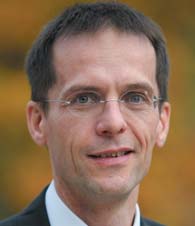|
Executive Interviews: Interview with Miklos Sarvary on Virtual World
April 2010
-
By Dr. Nagendra V Chowdary
 Carmine Gallo
Carmine Gallo Miklos Sarvary, Professor of Marketing and Dean of Executive Education at INSEAD 
How do you rate the performance
of the virtual campus? Would you
categorize it as a successful venture as
of now or one that would be
successful in the near future?
As one of the first business schools to
create a virtual campus, INSEAD has
received some very positive media
attention for being an early adopter of
these new technologies. Given our
long history of designing internetbased
business simulations and other
online tools, this is not very surprising, but our Second Life
campus has generated a positive buzz
that we hope to sustain! It has
provided us with an alternative tool
for extending our services and
keeping our stakeholders connected,
at relatively low cost, and at the same
time, allowed us to gain a better
understanding of the digital
marketplace through research and
teaching. In that sense the success of
our Second Life campus has so far
exceeded the initial investment, and
we hope to continue with more
positive outcomes!
What do you think would be the
enabling factors for the success of this
virtual campus?
We have not finished exploring or
discovering all the opportunities
provided by this environment. As
participants and faculty become more
familiar with virtual worlds, we hope
that the traffic, usage, and frequency
of events on our virtual campus will
increase.
What potential barriers do you feel
are holding the growth of virtual
campus? Also tell us something
about your competitors in this area?
Ideally, the technology needs to
continue evolving so that it is easier
for people to install and access
Second Life. The technology
requirements are not currently
standard to all computers and
corporate firewalls still pose a
problem. As more organizations
adopt virtual worlds, accessibility
should improve, as it did for the
Internet and the other standard office
applications. Until that happens,
there is a natural reluctance on the
part of some professors to take on the
risks involved. Other business
schools and universities are actively
exploring virtual worlds, but very
few have created a virtual campus
that is regularly used for teaching and
research. Organizations are certainly
using it for vocational training. For
example, this environment lends
itself particularly well to situational or
scenario-based training, within
industrial, military and medical
sectors.
For the next five years, how do
you see the future of Second Life
virtual campus? Would it be more
successful than the distance learning/
real life campus?
Experts predict that virtual worlds
will continue to be a fast growing
trend over the next five years at least,
so as more people create an avatar and
become familiar with virtual worlds,
hopefully it will become easier to
connect up. For some of our alumni,
virtual worlds are still a rather strange
and futuristic concept but this is
already changing quite quickly! On
the other hand, for many MBA
applicants, meeting up in Second Life
makes perfect sense. Online learners
are increasingly demanding and
expect to have fun while learning!
Virtual worlds are certainly more
compelling than traditional distance
learning, because you can interact in
real time with others in a shared
space, and there are more
opportunities for informal learning.
However, for optimum results, we
consider all our virtual tools as
complementary to the real life
experiences that we propose.
How do you feel about the rising
popularity of the virtual worlds like
Second Life and what impacts would
it have on the society? Will these
virtual worlds continue to be the next
big thing in the near future or will
they soon be passe?
Apparently our cognitive processes
respond better in a 3D environment
and we are more likely to remember
what we learnt if we can anchor that
knowledge to the memory of a
physical landmark or face (whether
virtual or real). Programmers are
writing scripts to enhance avatars’
facial expressions and mimic real
body language, and others are
working on the interoperability of
virtual worlds so that we can pass
from one world to another with the
same avatar. Many are working on
how to integrate 2D and 3D
applications and project 3D data. As
these functionalities are refined and
new ones introduced, I imagine that
virtual worlds will be more readily
used in many spheres of life. Virtual
worlds have the capacity to level out
differences, reduce inhibitions,
challenge perceptions and create
opportunities in a way that real life
cannot.
Businesses are making real money in
the virtual world and the market for
virtual goods is still growing,
especially in Asia. Therefore, it
seems likely that virtual worlds will
continue to progress and could
become as commonplace and userfriendly
as webpages are today. There
may be future applications of virtual
worlds that we can hardly imagine
right now, but hopefully INSEAD
will be well positioned to try them
out when the time comes!
|
The interview was conducted by Syed Abdul Samad (TL) and Fareeda (Sr. RA),
IBSCDC, Hyderabad. This interview was originally published in Effective Executive, IUP, Apr 2010.
Copyright © Apr 2010, IBSCDC
No part of this publication may be copied, reproduced or distributed, stored in a
retrieval system, used in a spreadsheet, or transmitted in any form or medium –
electronic, mechanical, photocopying, recording, or otherwise – without the permission
of IBSCDC. |
